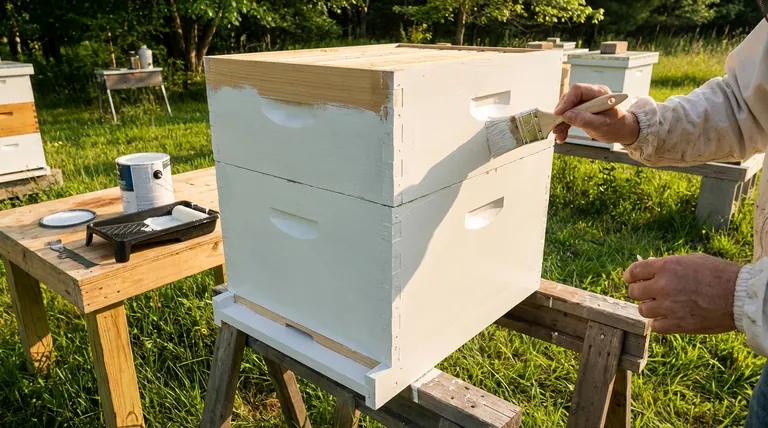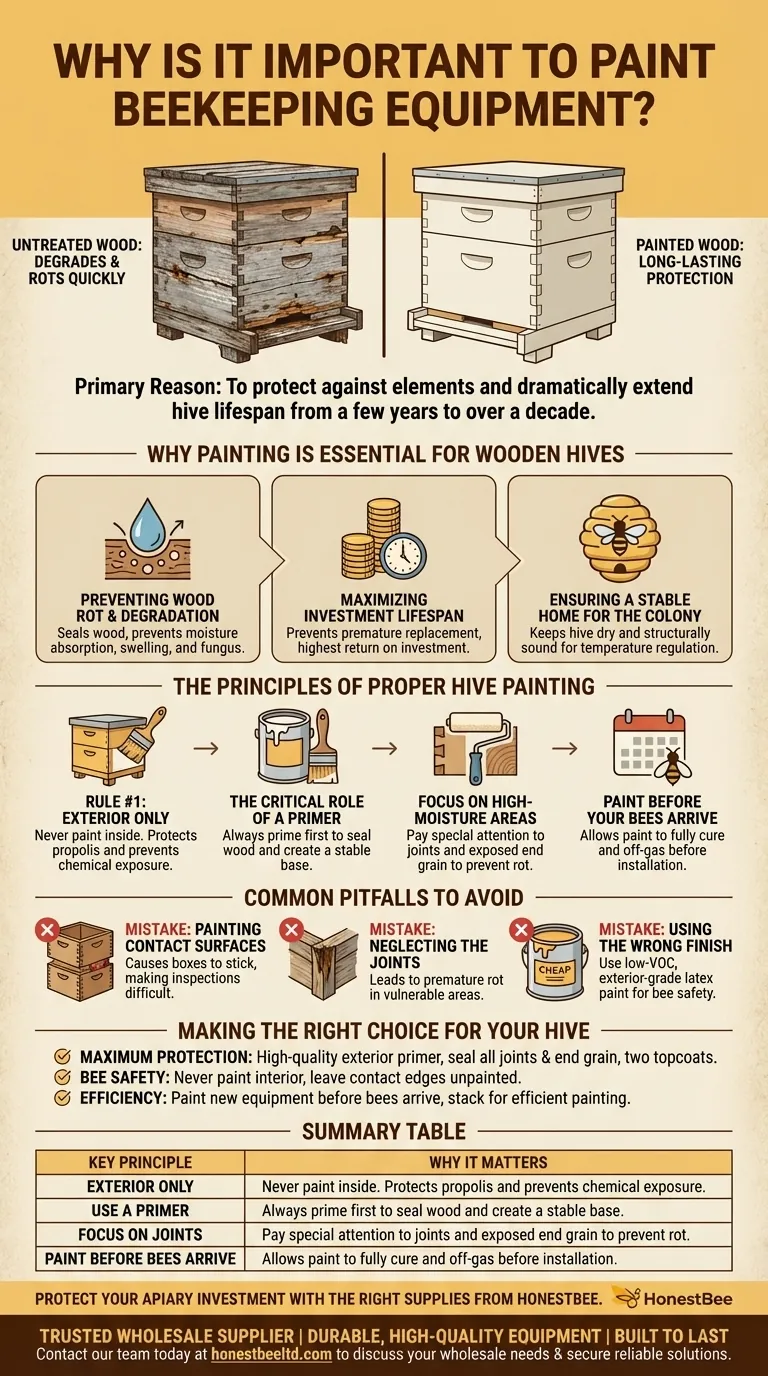The primary reason to paint beekeeping equipment is to protect it from the elements. Most beehives are made of pinewood, which degrades and rots quickly when exposed to rain, snow, and sun. A proper coat of paint acts as a crucial barrier, dramatically extending the functional lifespan of your hive from just a few years to potentially a decade or more.
While it may seem like a cosmetic choice, painting your wooden hives is one of the most important preventative maintenance tasks you can perform. It is a direct investment in the longevity of your equipment and the structural integrity of your bees' home.

Why Painting is Essential for Wooden Hives
The goal of painting is not to decorate the hive, but to create a durable shield against environmental forces that will inevitably break down untreated wood.
Preventing Wood Rot and Degradation
Untreated pine is highly porous and acts like a sponge for moisture. Constant exposure to rain and humidity causes the wood fibers to swell, soften, and become an ideal environment for fungus and rot. A quality paint job seals the wood, preventing this water absorption.
Maximizing the Lifespan of Your Investment
Beekeeping equipment represents a significant financial investment. A few dollars spent on paint and a primer can be the difference between replacing your hive bodies every few seasons versus having them last for many years. This simple step provides the highest return on investment for equipment longevity.
Ensuring a Stable Home for the Colony
A rotting, waterlogged hive is a poor home for honey bees. It can become drafty, damp, and structurally unsound, placing unnecessary stress on the colony and making it harder for them to regulate the hive's internal temperature and humidity.
The Principles of Proper Hive Painting
How you paint is as important as the act of painting itself. Following a few key principles ensures you protect the wood without harming the bees.
Rule #1: Exterior Only
Never paint the inside of your hive. Bees coat the interior walls with propolis, a resinous substance they collect from plants. This "bee glue" has antimicrobial properties and is integral to the colony's health. Paint can interfere with this process and introduce unnecessary chemicals into their living space.
The Critical Role of a Primer
Always start with a good quality exterior primer. A primer is designed to soak into the wood and create a sealed, stable surface for the topcoat of paint to adhere to. This step is especially critical for sealing wood joints and end grain.
Focus on High-Moisture Areas
Pay special attention to the box joints and any exposed end grain. These areas absorb moisture far more readily than the flat surfaces of the wood. Use a thick-nap roller (1/2" or 3/4") to push paint effectively into these crevices for maximum protection.
Paint Before Your Bees Arrive
It is significantly easier and safer to paint your equipment before a colony is installed. This allows the paint to fully cure and off-gas any volatile compounds without exposing the bees to fumes.
Common Pitfalls to Avoid
Mistakes in painting can create problems for both the beekeeper and the bees. Avoiding these common errors is critical for a successful setup.
Mistake: Painting Contact Surfaces
Do not paint the top or bottom edges of your hive bodies where they stack on top of each other. Paint in these areas will act like glue, causing the boxes to stick together. This makes hive inspections incredibly difficult and can lead to damaging the boxes when you try to pry them apart.
Mistake: Neglecting the Joints
Simply rolling the flat surfaces is not enough. The interlocking box joints are the most vulnerable part of a hive body. Failing to adequately work paint and primer into these joints will lead to premature rot, even if the rest of the box looks fine.
Mistake: Using the Wrong Finish
While many beekeepers use discounted "mistake" paint to save money, it's essential to ensure you are using a low-VOC (Volatile Organic Compound) exterior-grade latex paint. This is widely considered the safest and most effective option for beehives.
Making the Right Choice for Your Hive
Following a simple process will ensure your equipment is protected and your bees have a safe, durable home.
- If your primary focus is maximum protection: Always start with a high-quality exterior primer, paying extra attention to sealing all joints and end grain before applying two topcoats.
- If your primary focus is bee safety: Never paint the interior of the hive, and leave the top and bottom edges of each box unpainted to prevent them from sticking together.
- If your primary focus is efficiency: Assemble and paint your new equipment well before your bees arrive, and consider stacking the hive bodies to paint multiple exterior surfaces at once.
Properly protecting your equipment from the start sets the foundation for a healthy, thriving, and long-lasting apiary.
Summary Table:
| Key Painting Principle | Why It Matters |
|---|---|
| Exterior Only | Protects wood from weather without harming bees' interior propolis coating. |
| Use a Primer | Seals wood and joints for a stable, long-lasting paint surface. |
| Focus on Joints | Prevents rot in the most vulnerable, high-moisture areas of the hive. |
| Paint Before Bees Arrive | Allows paint to cure fully, ensuring bee safety from fumes. |
Protect your apiary investment with the right supplies from HONESTBEE.
As a trusted wholesale supplier for commercial apiaries and beekeeping equipment distributors, we provide the durable, high-quality equipment and supplies you need for a thriving operation. Ensure your hives are built to last from the start.
Contact our team today to discuss your wholesale needs and secure reliable, long-lasting beekeeping solutions.
Visual Guide

Related Products
- HONESTBEE Advanced Ergonomic Stainless Steel Hive Tool for Beekeeping
- Professional Dual-End Stainless Steel Hive Tool for Beekeeping
- Professional Galvanized Hive Strap with Secure Locking Buckle for Beekeeping
- Professional 3-Bar Frame Grip with Integrated Hive Tool
- Plastic Bee Hive Stand for Beekeeping
People Also Ask
- How is a hive tool used for scraping and cleaning? Master Hive Maintenance for a Healthy Colony
- How should beekeepers handle bees when using a hive tool? Master Calm, Deliberate Techniques
- What are the features of a regular hive tool? The Essential Multi-Tool for Every Beekeeper
- Why is it important to compare the progress of different hives? A Beekeeper's Key Diagnostic Tool
- What are some common uses of a hive tool? Essential Multi-Purpose Tool for Every Beekeeper



















